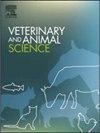抗促性腺激素释放因子接种和给药年龄对肥育后备猪里脊肉质特性的影响
IF 1.9
Q2 AGRICULTURE, DAIRY & ANIMAL SCIENCE
引用次数: 0
摘要
本初步研究评估了抗促性腺激素释放因子(anti-GnRF)疫苗接种和给药年龄对后备母猪(母猪)的影响,并特别关注了猪肉特性,包括营养成分、肉质和猪里脊的肌肉组织学。选取66头杜洛克×(长×大)后备母猪,随机分为3个试验组:(1)完整后备母猪;(2)在12周龄和16周龄时接受典型的免疫接种;(3)在9周龄和13周龄早期接种免疫后备母猪,这是厂家推荐的最早接种时间。在24周龄时屠宰猪,从所有组中收集肉样本进行分析,包括完整后备母猪(MIG)的肉样本,12和16周龄接种后备母猪(MV12/16)的肉样本,以及9和13周龄接种后备母猪(MV9/13)的肉样本。免疫后的后备母猪肉中肌内脂肪(IMF)含量显著高于对照组(P < 0.05),并伴有脂肪酸谱的变化(不包括多不饱和脂肪酸),但对肉质和肌肉组织学没有不良影响。MV12/16和MV9/13样品之间无显著差异。这些结果表明,抗gnrf疫苗接种可提高猪肉中IMF的含量,而不影响肉品质或肌肉结构。此外,给药年龄对化学成分、肉质或肌肉组织没有影响。早期疫苗接种计划提供了一种切实可行的方法,可以改善后备母猪生产管理,促进更容易的生猪处理,有效的疫苗接种管理,并加强基金组织的沉积。本文章由计算机程序翻译,如有差异,请以英文原文为准。
Effects of anti-gonadotropin-releasing factor vaccination and administration age on the meat characteristics of pork loins from finishing gilts
This pilot study evaluated the effects of anti-gonadotropin-releasing factor (anti-GnRF) vaccination and administration age on gilts (female pigs), with a specific focus on meat characteristics, including nutritional composition, meat quality, and the muscle histology of pork loins. A total of 66 Duroc × (Landrace × Large White) gilts were randomly assigned to three experimental groups: (1) intact gilts; (2) immunized gilts receiving a typical vaccination at 12 and 16 weeks of age; and (3) immunized gilts receiving early vaccination at 9 and 13 weeks of age, which is the earliest schedule recommended by the manufacturer. The pigs were slaughtered at the market age of 24 weeks, with meat samples collected from all of the groups for analysis, including meat samples from intact gilts (MIG), meat from gilts vaccinated at 12 and 16 weeks (MV12/16), and meat from gilts vaccinated at 9 and 13 weeks (MV9/13). Meat from the immunized gilts had significantly higher intramuscular fat (IMF) content than MIG (P < 0.05), accompanied by changes in the fatty acid profile—excluding polyunsaturated fatty acid—without adverse effects on meat quality or muscle histology. No significant differences were observed between the MV12/16 and MV9/13 samples. These findings suggest that anti-GnRF vaccination enhances the IMF content in pork without affecting meat quality or muscle structure. In addition, the administration age did not influence the chemical composition, meat quality, or muscle histology. An early vaccination schedule provides a practical approach to improve gilt production management, facilitating easier pig handling, efficient vaccination administration, and enhanced IMF deposition.
求助全文
通过发布文献求助,成功后即可免费获取论文全文。
去求助
来源期刊

Veterinary and Animal Science
Veterinary-Veterinary (all)
CiteScore
3.50
自引率
0.00%
发文量
43
审稿时长
47 days
 求助内容:
求助内容: 应助结果提醒方式:
应助结果提醒方式:


